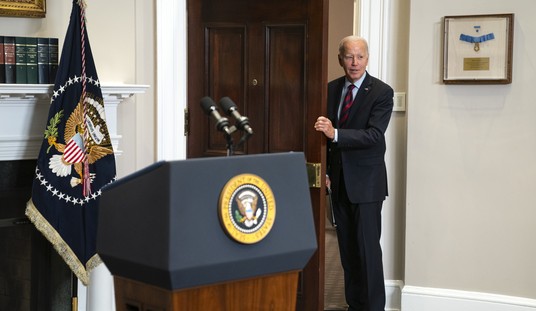It took Republicans three tries to win control of the US Senate and consolidate Congress under their leadership. In the end, the landscape left by the 2008 Democratic triumph left them uniquely vulnerable in the sixth-year midterm of an unpopular presidency. The tables will turn in 2016, warns National Journal’s Charlie Cook, as the gains of 2010 will make Republicans highly vulnerable to losing control of the Senate once again:
Today, The Cook Political Report puts two Republican-held seats in the “Toss Up” category—the open seat in Florida and Kirk in Illinois. That toss-up column will certainly grow as the recruiting season progresses. If Democratic Gov. Maggie Hassan challenges Ayotte in New Hampshire, former Democratic Sen. Kay Hagan runs against Republican Sen. Richard Burr in North Carolina, and former Democratic Sen. Russ Feingold stages a rematch with Johnson in Wisconsin, all of those races would become toss-ups. Democrats are trying to recruit a stronger candidate in Pennsylvania to challenge Toomey. If they succeed, Toomey would also land in the toss-up column. Ohio, where Republican Sen. Rob Portman is seeking a second term, has the potential to end up in the toss-up column as well.
There remain a lot of “ifs” out there, but if Democrats get the candidates they want, as many as seven seats could end up in the Toss Up column, which is more than enough to net Democrats four or five seats.
Beyond this group of seven seats, though, it is harder for Democrats to expand the playing field further. They talk about waging competitive races against Sen. Lisa Murkowski in Alaska and Sen. John McCain in Arizona, but the chances that they will are pretty remote today.
If Republicans can’t hold onto their advantages in those races, they will have almost no opportunity to make up ground elsewhere:
On the Democratic side of the aisle, only the open seat in Nevada is in the Toss Up column today. The only other seat that is likely to be in play is in Colorado, where Democratic Sen. Michael Bennet is seeking a second full term. Beyond that, it isn’t likely that Republicans can make any of the other eight Democratic-held seats competitive. This means that Republicans don’t have a lot of opportunities to offset their losses.
Cook notes that one potential wild card will be the presidential race. Republicans won in 2014 thanks to an early onset of fatigue with Barack Obama, and that may become more pronounced by the time 2016 arrives. Obama didn’t win the blue states with Republican Senators by as wide a margin as Mitt Romney won the red states in 2012 that flipped in the Senate in 2014. That means that the races may well depend on whether Democrats opt for more of the same old thing at the top of the ticket — and whether Republicans do, for that matter — or find a new direction that will energize voters on the ground.
This is yet another data point for why 2016 will be a generational inflection point in American politics. It’s not just the presidential election, although that is the greater part of it. It’s also a decision point for American voters after eight years of progressive incompetence on economics and foreign policy, both of which involve the Senate. At least a few of these states, namely North Carolina, Wisconsin, New Hampshire, and even Pennsylvania, are in reach for a Republican presidential candidate who speaks to the future rather than the past and which excites and motivates a broad swath of middle-class voters tired of being left behind by the divisive politics of the Left.
That may be why Pat Toomey is doing unusually well in Pennsylvania. A Harper poll of likely voters last week showed Toomey far in front of his presumed challenger, former Rep. Joe Sestak, and well above the 50% mark that usually shows safety for incumbents:
Senator Pat Toomey is showing favorable gains with respect to voter perception of the first-term incumbent. More than half of likely voters have a favorable opinion of Toomey (54% favorable, 32% unfavorable). He is viewed favorably in every region of the state (Northern Tier: 45% favorable, Philadelphia/Southeast: 52%, Pittsburgh/Southwest: 55%, Scranton/Lehigh Valley: 53%, South Central: 60%) as well as among Republicans (72% favorable), self-identified Conservatives (73% favorable), Independents (54% favorable) and Moderates (49% favorable). The Republican’s favorable standing with unconventional constituencies may affirm the Senator’s inclination to chart a more moderate course at times. …
Republican Senator Pat Toomey holds commanding early leads over three potential Democratic challengers in the race for Senate. Toomey leads declared candidates Joe Sestak (53-32%) and Ed Pawlowski (55-30%) by 21% and 25%, respectively. Josh Shapiro trails Toomey by the largest margin (55-27%). Toomey consistently receives stronger support from his own party than the Democrats do from theirs and he also earns 20% or more of the Democratic vote in all three match-ups. Toomey leads Pawlowski and Shapiro by significant margins in their home regions (Scranton/LV: Toomey 57%, Pawlowski: 31%; Philadelphia/Southeast: Toomey 51%, Shapiro: 37%).
Notably, Toomey even edges Sestak in the Philadelphia region, 47/44, the most liberal part of the state. He’s trouncing Sestak among younger voters, 50/35, although the age range is quite wide (18-39YOs). Sestak wins the African-American vote, but only by 56/33.
If Republicans want to compete in these states at the presidential level, they may want to learn how they’re staying so competitive at the state level.







Join the conversation as a VIP Member